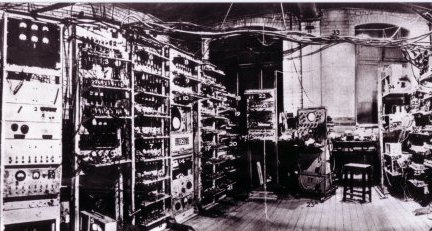At 60, 'Baby' celebrates birth of computing

On Saturday, it will be exactly 60 years since the world's first stored-program, electronic, digital computer flickered into life in a laboratory at the University of Manchester.
The computer was immediately nicknamed 'Baby' — something of a misnomer, since it was an enormous device. Its size is illustrated by a picture of the device (below) that recently turned up in an old file at the university.
But the picture only shows one part of Baby, as university press officer Alex Waddington explained: "There was a full panoramic shot of Baby, which was made by photographing it bit by bit, and then fitting the pictures together in one long picture. I've checked all the material we published back then and also the clippings from the media, and I can't see the full panoramic shot anywhere, so it seems it was never released."
Crucially, the picture does not show the output device. The output was, in fact, "read directly from the face of a CRT [cathode ray tube]", Waddington said.The Small-Scale Experimental Machine, as Baby was officially named, successfully executed its first program on 21 June, 1948.
By today's standards, Baby was an extremely primitive machine. In modern terms, the prototype Baby had a random access memory (RAM) of just 32 locations or 'words'. Each word in the RAM consisted of 32 bits (binary digits) and a total of 1,024 bits of memory. According to Waddington, the computing speed was 1.2 milliseconds per instruction, equivalent to a clock speed of slightly under 1kHz, more than two million times slower than a typical desktop processor today.
Waddington pointed out that an 80GB Apple iPod "is capable of storing 640 million times more information than the original Baby".
Baby was built using metal racks from the Post Office along with hundreds of valves, and the keyboard was a series of push buttons and switches, mounted vertically.
All this year, the University of Manchester will be hosting a series of events to celebrate the birthday of Baby and the work of its inventors, Tom Kilburn and Freddie Williams.
